
1943

December 21, 1947
Left click on the images below for larger versions.

1943 |

December 21, 1947 |
Left click on the images below for larger versions.

|

|
Left click on the images below for larger versions.

c1940 |

1870 |

1934 |

1930's |

1940's |

1970's |

|

|

1957 |

|
The photograph above, left, is circa 1940.
Left click on the images below for larger versions.

1976 |
Left click on the images below for larger versions.

|

|
Left click on the images below for larger versions.

|

|

|

|

|

|

|

|

|

|

|

|

|

|

|

December 2, 1923 |

1908 |

|

May 25, 1926 |

|

1885 |

|

1892 |

|

1890 |

1892 |

September 24, 1863. |
William P. Jarvis, an attorney, built his octagon house of red brick made at the Morris kiln. The brick for Governor Farwell's octagonal house also came from this kiln. It was 2 stories with sawed wooden cornice trim. The angles were beige colored brick quoins and 4 of the 8 sides had a gabled roof with a chimney. The back side of the house had an exposed basement with a 2-story porch on the back wall. Above the front door was a bracketed, free-standing balcony for the 2nd story French doors.
Only three of the fourteen rooms in the house were four-sided. The house later had a spiral staircase from the first to the fourth floor, and had eighteen steps per flight. Mr Jarvis ran out of money building the home and had to mortgage it. In 1866 A. J. Ward, a Civil War surgeon, purchased the home. Then his daughter, Mrs. Charles T. Atwood, took possession until 1926 when it was sold to the Knights of Pythias. In 1933 it became a Salvation Army post and the red bricks were painted blue. In 1976 the exterior was cleaned, revealing the red bricks again, but then a fire gutted the structure. Being in a highly desirable neighborhood, it was decided to raze the building. E.L.P.
As the neighborhood around it changed, the structure changed from a home to a commercial structure. A last minute attempt to restore the home was thwarted by a fire, in which it was gutted, and is now gone. The following photographs, provided by the ELPuerzer achieve, show the structure in different phases of its existence.Left click on the images below for larger versions.

|

|

|

|

|

|

|

|

|

1892 |

|

|
A third octagon house (of a possible 5 total) was standing in Dane County. A Dec. 29,1869 Milwaukee Sentinel records the destruction of a brick octagon house caused by a chimney fire. The home was owned by a mason named Kenneth C. McKay and appears on an 1867 birdseye map.
It was a single story house across from Beecroft's Department store. McKay still lived on University Ave at 626 in 1877 . He continued to reside on that street until 1923. Whether he rebuilt the octagon or another home isn't known. He was a mason and the home was described as brick with a basement and attic. In 1899 the Mckay home suffered another small fire.
Left click on the images below for larger versions.

1869 fire |

1867 |

1867 |

1873 |

1894 |

|

1899 fire |

1892 |

|
Left click on the images below for larger versions.

|

|

|

|

|

|

|

|

|

1873 |

|
1984 Horicon Reporter article.
Williamm Croft octagon house is constructed of two layers of brick, with an air space between them. The inside of the walls are covered in plaster, with interior walls built on wood framing with a lathe and plaster surface. A belvedere, gone since 1924 gave unlimited views of the surrounding countryside, with an octagonal chimney topping the composition. Construction took two years to complete.
The Crofts lived in their home until 1876 with C Miller residing there until 1900. It was then purchased by Adolph Kruel Sr the father of the present owner at this writing, Paul and Doris Kruel. Paul purchased the house and its full acre of yard space in 1939.
Although Paul was too young to remember, he was often told that previous owners used to watch a nearby Winnebago Indian village from the belvedere atop the house. It is assumed that the Indians were taking advantage of the abundant fish and wildlife available at the nearby Horicon Marsh before they were pushed to points north and west.
"I was born in 1914, and they had all disappeared by that time." said Paul.
An oak tree that no longer stands in the yard once bore a gash that indicated it was the starting point for a survey of the then-young city.
When Paul was growing up he well remembered how crowded the house had become to a family of nine including five boys and two girls.
"We slept three to a bed while growing up and in the winter the frost was so thick on the walls that we could write our name on it." Paul recalls. "We all ran down to the Round Oak Stove, which burned coal, in the living room to get dressed."
Paul remembered also that he and his brothers spent all year chopping wood to pile in the basement for the coming winter. “That's all we kids ever did was to cut wood with a buck saw.”
Paul also recalls the havoc caused by the steam locomotives that passed close by on the tracks that still run on the south side. "When we heard the steam engine Mom would run to get the clothes in because the soot would soil the clean clothes hung out to dry."
Paul's father built a large kitchen in 1924 , using cement and cement block to complete the addition. That portion of the house is now used for a dining room and an office. Dornfeld 1980 Come see more in Horicon History book at the Satterlee Clark Home. Open house August 24th 1-4
An English immigrant who settled in Horicon not only published the first local newspaper, but left the community with a historical landmark - the Croft Octagon House.
William E. Croft put out the first issue of the "Argus" the forerunner of the "Horicon Reporter," on Sept. 7 1854. Less then a half dozen months later, on February 6, 1855, footings for the eight sided house, located what is now 219 Valley St, were laid.
The site, located on a hill where Joel Doolittle constructed the first log house in Horicon, reportedly afforded a view of the Winnebago Indian village that was located on the opposite shore of the Rock River. The foundation wall of the house of Asiatic-Indian architecture is of huge stones with railroad irons cemented between them. In the middle of the ground level basement stands a 3.5 foot thick reinforcing wall of stone and concrete. The basement, with its huge timbers and iron supports is eight feet in height and has six windows. To be continued Dornfeld 1980
Left click on the images below for larger versions.
|
1914 |
|

|
|
|
|
|
|
|
1892 |
Pre 1900 |
|
1890 |
|
October, 2012 |
|
|
|
Left click on the images below for larger versions.
|
1890 |
Left click on the images below for larger versions.

|

|

|

|

|

|

|

1975 |

1975 |

|

|

|

|

|
This school reportedly built in late 1800s in Highway C in Downsville served for 50 yrs as a school. In 2007 John Thomas purchased and moved it to Creasey St (Highway 25 and C) a mile distance,where he and his wife opened it as a pottery shop and tourist center. Floor joists and wall plaster was replaced, drywall added. One beam marked 1894 might be the date of construction.
Some original windows remain after remodeling as well as a few light fixtures. The 800 sq foot. building is below grade in back making it 1 1/2 stories. Undated newspaper photo shows it prior to remodeling.
Left click on the images below for larger versions.

|

|

|
Left click on the images below for larger versions.

|

|

|

|

|

|

1910 |

|

1894 |
Left click on the images below for larger versions.

|

1870 |

1897 |
|

1889 |

1889 |

|

1880 |
Left click on the images below for larger versions.

|

1872 |

1889 |

1897 |
Left click on the images below for larger versions.

|

|

|

Circa 1974 |

Circa 1975 |

|
Left click on the images below for larger versions.

|

|

|
Left click on the images below for larger versions.

|

|

|

1892 |

1902 |

|

|

1908 |
Left click on the images below for larger versions.

|

|

|

|

|

|

August, 1976. |

November 12, 1971. |

March 13, 1973 |

|

|

1915 |

Underground railroad myth - 1 |

Underground railroad myth - 2 |

|

|

|

|

|

|

|

|

|

|
Left click on the images below for larger versions.

|
Left click on the image below for a larger version.
Left click on the images below for larger versions.

|

|

|

|

1893 |

|

1974 |

|

|

|

|

|

|

|
Left click on the images below for larger versions.

|

|

|

|
Left click on the images below for larger versions.

|
Left click on the images below for larger versions.

|

1893 |

1893 |

|
Left click on the images below for larger versions.

|

|
Left click on the images below for larger versions.

|

|
Left click on the image below for a larger version.

Left click on the images below for larger versions.

|

|

|

|

|
Left click on the images below for larger versions.

|

|

|

|

|

|

|

1895 |

|

1895 |
Left click on the images below for larger versions.

|

1895 |

|
1861 - Built
1866 - Sold to Hezekiah W Whitney – President of Monroe Manufacturing Co
Sold to Ferdinand Grunert – cheese dealer ( lived there in the 1900 city directory
Sold to Postmaster Robert Etter (could not find this name in the city directory)
1906-1949 - Ernest Zuercher
1949 - sold to Arlene Berkely (no info on this person)
1950 - City directory lists owner as mary Krauss
1952 - Lists owner as Wm Krauss w/ others living there. Wonder if it perhaps became a rooming house. Robt Sonderegger, Selma Ladner, Ms M.A. Reusser all listed as living there.
1964 - Sold to Margaret Loveland
1972 - Currently owned by Mrs Rudolph (Sue) Regez. Thanks to Linda Lostetter. Green Co. Historical Society.
Left click on the images below for larger versions.

|

|

|

|

|

|

September 15, 1983 |

1949 |
Left click on the images below for larger versions.

|

|

|

1873 |
Left click on the images below for larger versions.

Undated |

|

|

|

1952 |

1952 |

|

|

|

Undated |
Left click on the image below for a larger version.
Left click on the images below for larger versions.

|
Left click on the images below for larger versions.

|

|

|

|

|

|

|
Left click on the images below for larger versions.

|

|

|

|

|

|

|

|

|

|

|

|

Postcard - ca1920. |

c1910 |

|

|

1885 |

1928 |

September 1, 1930 |
Left click on the images below for larger versions.

|

|

|

|
Left click on the images below for larger versions.

|

|

|

|

|
The miniature, below, built as a WPA project for the Watertown Centennial stood initially in Riverside Park. The work was done by local craftsman Henry Martin, with assistance from Paul Mohr and William J. Creapo. Used as a float in a 1936 centennial parade, It was later moved up to the grounds of the Octagon House to show what the place looked like with porches.
Left click on the images below for larger versions.

|

|
Left click on the images below for larger versions.

|
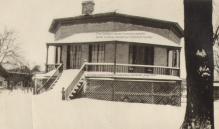
|

|

|

1885 |

Edwin Quiner |

1867 |
In 1890 David R Lewis purchased it. His grandson David owned it until his death in 2007 and land developers was gifted it to the Historical Society who were responsible for its move to its current location ( very near where it was originally built. After 1978, a long addition/barn was added to it but that was removed when the Society took it over and moved it.
Left click on the images below for larger versions.

|

|

After 1870s move. |

2012 photograph. |

2012 photograph. |
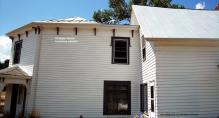
2012 photograph. |

Foyer |

Parlor |

Bookcase |

Bedroom |

Master bedroom - first view. |

Master bedroom - second view. |
Aerial views:

|

|
Left click on the image below for a larger version.
In 1921 the Oliver Gullickson's bought the house who rented the apartment/wing to their son Dr. Lynn( he was a dentist), and wife Rachel . Lynn was politically active with the Republican party until his 1944 death. When Rachel died at age 98 in 1991, she sold the house to the West Salem historical society.( She was responsible for buying back many originals family furnishings )
Left click on the image below for a larger version.
Left click on the images below for larger versions.
Left click on the image below for a larger version.
Aerial views:

|

|
Left click on the images below for larger versions.

|

|

|

|

|

1878 |

1954 |

1947 |

August 14, 1937 |

1894 |
Left click on the images below for larger versions.

|

|

|

|

1880 - 1890 |

|

1940s. |

|

|

Photo from 1950s. |
Left click on the images below for larger versions.

|

1910 |
Left click on the images below for larger versions.

|

|

|

|

|

|

|

|

|

|
Left click on the images below for larger versions.

|

1968 |

1968 |

1977 |

1901 |

|
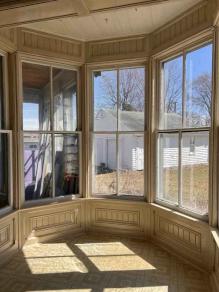
|
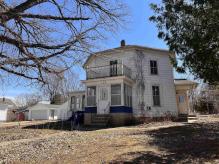
|
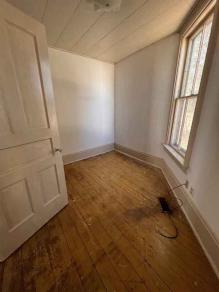
|
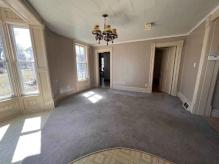
|
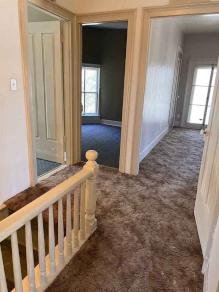
|
Left click on the images below for larger versions.

Left, 1961, right, 2013. |
Left click on the images below for larger versions.

|

1961 |

February 26, 1958. |

January 2, 1958. |

1947 |

November 7, 1948. |

2013 |

2013 |

December 26, 1957 |

December 27, 1957 |

September 25, 2014 |

September 25, 2014 |

September 25, 2014 |
Left click on the images below for larger versions.

1871 map. |

|

1896 map. Octagon gone. |

Photo circa 1905. |
Left click on the images below for larger versions.

|
Left click on the images below for larger versions.

|

|

|

2013 |

1873 |

|

|

1873 |

June 7, 1979 |

October, 2012 |
Left click on the images below for larger versions.

|
Left click on the images below for larger versions.

1870 |

|

1881 |
Left click on the images below for larger versions.

|

|

|
|

|
Left click on the images below for larger versions.

|

|

|

|

|
Left click on the images below for larger versions.

|

|

|

|

|
Left click on the images below for larger versions.

|

|

|

|
Left click on the images below for larger versions.

The Sheboygan Press, March 23, 1956. |

|
Left click on the images below for larger versions.

1877 photograph. |

|

|

Postcard image. |

|

|

Postcard image. 1908. |

1974 |

1891 |
Left click on the images below for larger versions.
Left click on the image below for a larger version.
Left click on the images below for larger versions.

|

|

|

|

|

|

|

|

|

|

|

|

1891 |

HABS - 1933. |

1891 |

1966 |

As an antique store. |
Left click on the image below for a larger version.
Left click on the images below for larger versions.

|

|

|

|

|

|

February 18, 1992 |

October 23, 1983 |

1934 |
Left click on the images below for larger versions.

|

|

Restored, with period colors. |

1891 |

1911 |

|

2015 |

2015 |

|

|

|

|

|

|
Left click on the images below for larger versions.

|

|

|

|

|

1855 |

|

|

|

Entry. |

Kitchen. |

1940 |

1954 |

c1970 |

c1885 |

1891 |
Left click on the images below for larger versions.

|

|

April 16, 1980 |

|
Left click on the images below for larger versions.

|

|
Left click on the images below for larger versions.

|

|

|

|

|

|

|

January 3, 1960 |

October 28, 1984 - part 1 |

October 28, 1984 - part 2 |

August 7, 1932 - part 1 |

With porches. |

1873 |

1891 |

|

1920 |

Josiah Newell West |

|
Left click on the images below for larger versions.

|

|

|

|

|

1871 |
Left click on the images below for larger versions.

|

|

|

1966 |

1879 |

1906 |

1913 |

|

1913 |

July 26, 1966 |
The house has been enlarged on three different occasions. The photograph at the left, in the photographs below (two men near a fench), taken in the 1870s. A portion of the porch had been enclosed.
The middle photograph above is from a stereoview. The date is not known.
The right hand photograph, taken in perhaps in the 1940s, shown a lower cupola, and the stylish filial atop the roof is gone. The railing above the cornice is gone, as is the railing along the roof line. It also appears that the porch has been replaced. The fence along the street is gone.
Left click on the images below for larger versions.

|

|

|
Left click on the images below for larger versions.

|

|

|
Left click on the image below for a larger version.
Left click on the images below for larger versions.

|

|

|

|

|

|

|

|
Left click on the images below for larger versions.

1976 photograph. |

c1967 photograph. |

|

|

|

|

|

|

|

1903 |

1902 |

|
Left click on the images below for larger versions.

|